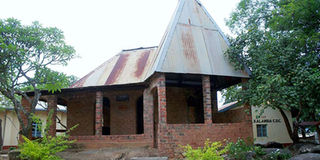At Kalamba lies the origin of AIC church in Kenya

African Inland Church (AIC) in Kalamba. This church was built in 1932. PHOTO | PIUS MAUNDU | NATION MEDIA GROUP
What you need to know:
- The church complex owes its existence to the work of European evangelists who traversed the countryside in the 19th century to spread Christianity.
- Makueni County government has built a cultural centre at the church complex to keep AIC history alive.
Standing amidst rolling hills at the heart of Makueni County surrounded by farm houses and patches of maize and fruit trees is an unassuming relic — African Inland Church (AIC), Kalamba.
The church complex owes its existence to the work of European evangelists who traversed the countryside in the 19th century to spread Christianity.
The writing at the gate announces that this is the epicentre of the Africa Inland Mission (AIM) in the region.
The church’s features are reminiscent of the 19th century era: baked mud bricks, tin roof, foundation built on a boulder and arches on the windows and doors.
Inside the quaint church are files of wooden pews standing on the uneven rocky floor beneath.
This church was built in 1932 to replace the very first one that the missionaries built using local materials.
GOSPEL
Curious scholars studying how the Christian mission that birthed AIC chose to settle at this place return fascinating accounts.
Watson Omulokoli, for instance, says that the man behind the AIM, Reverend Peter Cameron Scott, had sailed from Scotland and, on landing in Mombasa in 1895, trekked for two weeks into the countryside, other missionaries in tow.
Their intention was to penetrate as far as possible into the interior and establish a Christian mission far away from the coastline where other missionaries had already set base.
Mr Omulokoli’s account, which was published in 1995 in the African Journal of Evangelical Theology, concurs with the church history as chronicled in the AIC website.
It states that Scott came from the US “though he was not born in America”.
MALARIA
It is not clear whether Scott and his entourage take credit for the dusty murram road that leads to Kalamba market, which borders the AIC Kalamba as it slices through the heart of the county - from Emali town to Ukia shopping centre on the Wote-Machakos road.
Over the years, the work of AIM evangelists would multiply a thousand-fold to over 3,000 churches spread across the region and beyond, just like the Biblical mustard seed.
According to folklore, Scott died in 1896 when Syumbesa, a local witch who was opposed to his evangelism, sent a swarm of bees that attacked the missionary.
Mr Stanley Kitati, the pastor in charge of the Kalamba AIC, however rubbishes the witchcraft allegations as unfounded.
Although he agrees that a witch by the name Syumbesa existed in the area and that he was indeed opposed to the spread of Christianity, Mr Kitati says that Scott succumbed to malaria.
DIVINE
The missionaries are buried in tombs located at the church complex that includes a modern church building, a primary school and a dispensary.
Makueni County government has built a cultural centre at the church complex to keep AIC history alive.
Mr Aron Mbuvi, who once served at the Kalamba church for 10 years, and has since been researching about the AIM missionaries, is convinced that the missionaries settling for Kalamba was divine.
“This region was densely forested. So, we cannot say the missionaries were attracted by the allure of the hills because the hills could not be seen from a distance. The AIM missionaries’ choice for Kalamba must have been divine,” he said.
Mr Mbuvi’s theory is popular among the highly superstitious natives who place Nzaui Hills at centre of the Kamba mythology.
The first Kamba family descended straight from heaven and landed on this boulder, according to folklore, which is accentuated by impressions of human footprints on a rock on the hill overlooking the site of the Kalamba AIC church.





